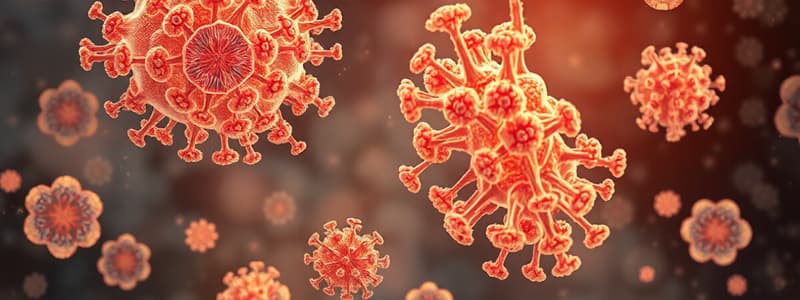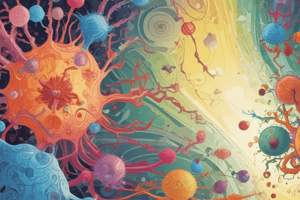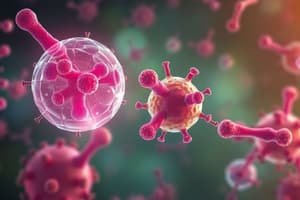Podcast
Questions and Answers
Which of the following is NOT encoded by the MHC class I locus?
Which of the following is NOT encoded by the MHC class I locus?
- HLA-D (correct)
- Transporters associated with antigen processing (TAP)
- HLA-A
- β2-microglobulin
Which cells are primarily responsible for expressing MHC class II proteins?
Which cells are primarily responsible for expressing MHC class II proteins?
- Epithelial cells
- Dendritic cells (correct)
- Brain cells
- Retinal cells
What is the function of β2-microglobulin?
What is the function of β2-microglobulin?
- It is a co-receptor for CD4+ T cells.
- It is a transmembrane glycoprotein that interacts with antigen peptides.
- It is involved in the transport of antigens to the cell surface.
- It associates with the transmembrane glycoprotein of MHC class I molecules. (correct)
Which of the following statements about MHC class I is TRUE?
Which of the following statements about MHC class I is TRUE?
Which property of the MHC helps to ensure that pathogens cannot evade antigen presentation?
Which property of the MHC helps to ensure that pathogens cannot evade antigen presentation?
What is the main role of MHC class II proteins in the immune response?
What is the main role of MHC class II proteins in the immune response?
Which of the following genes is NOT involved in antigen processing?
Which of the following genes is NOT involved in antigen processing?
Which of the following proteins is encoded by the MHC Class III locus?
Which of the following proteins is encoded by the MHC Class III locus?
Which of these factors can influence the immunogenicity of a molecule?
Which of these factors can influence the immunogenicity of a molecule?
What is the minimum molecular weight of a molecule that is generally considered weakly immunogenic?
What is the minimum molecular weight of a molecule that is generally considered weakly immunogenic?
Which of these options describes a T-independent antigen?
Which of these options describes a T-independent antigen?
What is the primary function of MHC molecules?
What is the primary function of MHC molecules?
What is the role of dosage, route, and timing of antigen administration in the immune response?
What is the role of dosage, route, and timing of antigen administration in the immune response?
Which of these molecules are classified as T-dependent antigens?
Which of these molecules are classified as T-dependent antigens?
What is the main difference between T-dependent and T-independent antigens?
What is the main difference between T-dependent and T-independent antigens?
Which of these factors contribute to the rejection of tissue grafts?
Which of these factors contribute to the rejection of tissue grafts?
Which of the following is NOT a characteristic of a good immunogen?
Which of the following is NOT a characteristic of a good immunogen?
What is the specific molecular structure that interacts with a single antibody molecule or TCR called?
What is the specific molecular structure that interacts with a single antibody molecule or TCR called?
Which of these statements about epitopes is TRUE?
Which of these statements about epitopes is TRUE?
What is the primary function of an adjuvant in a vaccine?
What is the primary function of an adjuvant in a vaccine?
Which type of immune response is responsible for eliminating intracellular pathogens?
Which type of immune response is responsible for eliminating intracellular pathogens?
What is the term for the unresponsiveness of the immune system to self-antigens?
What is the term for the unresponsiveness of the immune system to self-antigens?
Which of the following factors can influence the immunogenicity of an antigen?
Which of the following factors can influence the immunogenicity of an antigen?
What is the difference between an antigen and an immunogen?
What is the difference between an antigen and an immunogen?
Haptens are small molecules that cannot initiate an immune response on their own. How can they be made immunogenic?
Haptens are small molecules that cannot initiate an immune response on their own. How can they be made immunogenic?
Which of the following is an example of central immune tolerance?
Which of the following is an example of central immune tolerance?
What is the key process by which exogenous antigens are processed and presented to T cells?
What is the key process by which exogenous antigens are processed and presented to T cells?
Which of the following is true about the generation of MHC class I associated peptides?
Which of the following is true about the generation of MHC class I associated peptides?
Which type of T cell recognizes lipids presented by the MHC class I-like molecule CD1?
Which type of T cell recognizes lipids presented by the MHC class I-like molecule CD1?
What is the main feature that distinguishes γδ T cells from conventional CD4+ and CD8+ T cells?
What is the main feature that distinguishes γδ T cells from conventional CD4+ and CD8+ T cells?
Which of the following is NOT a type of antigen recognized by γδ T cells?
Which of the following is NOT a type of antigen recognized by γδ T cells?
Which type of cell can internalize virus-infected cells or tumor cells to present viral or tumor antigens?
Which type of cell can internalize virus-infected cells or tumor cells to present viral or tumor antigens?
What is the approximate size of peptides that bind to MHC class II molecules?
What is the approximate size of peptides that bind to MHC class II molecules?
Which cellular compartment is involved in the loading of peptides onto MHC class II molecules?
Which cellular compartment is involved in the loading of peptides onto MHC class II molecules?
What is the major mechanism for generating peptides from cytosolic protein antigens for MHC class I presentation?
What is the major mechanism for generating peptides from cytosolic protein antigens for MHC class I presentation?
Which of the following is NOT a function of MHC molecules in T cell activation?
Which of the following is NOT a function of MHC molecules in T cell activation?
Flashcards
Foreignness in Immunology
Foreignness in Immunology
Molecules recognized as 'nonself' trigger an immune response; 'self' molecules do not.
Immunogenic Size
Immunogenic Size
Immunogens are more effective when large; small molecules (<10,000 Da) are weakly immunogenic.
Chemical Complexity
Chemical Complexity
Immunogenicity increases with structural complexity; heteropolymers are more immunogenic than homopolymers.
Genetic Host Factors
Genetic Host Factors
Signup and view all the flashcards
Dosage and Administration
Dosage and Administration
Signup and view all the flashcards
T-independent Antigens
T-independent Antigens
Signup and view all the flashcards
T-dependent Antigens
T-dependent Antigens
Signup and view all the flashcards
Major Histocompatibility Complex (MHC)
Major Histocompatibility Complex (MHC)
Signup and view all the flashcards
MHC Class I molecules
MHC Class I molecules
Signup and view all the flashcards
MHC Class II molecules
MHC Class II molecules
Signup and view all the flashcards
Antigen processing
Antigen processing
Signup and view all the flashcards
Endocytic vesicles
Endocytic vesicles
Signup and view all the flashcards
Proteasome
Proteasome
Signup and view all the flashcards
T-cell activation
T-cell activation
Signup and view all the flashcards
NKT cells
NKT cells
Signup and view all the flashcards
γδ T cells
γδ T cells
Signup and view all the flashcards
CD1 molecules
CD1 molecules
Signup and view all the flashcards
Peptide-binding clefts
Peptide-binding clefts
Signup and view all the flashcards
MHC
MHC
Signup and view all the flashcards
MHC Class I
MHC Class I
Signup and view all the flashcards
MHC Class II
MHC Class II
Signup and view all the flashcards
Polygenicity
Polygenicity
Signup and view all the flashcards
Polymorphism
Polymorphism
Signup and view all the flashcards
CD8-positive T cells
CD8-positive T cells
Signup and view all the flashcards
CD4-positive T cells
CD4-positive T cells
Signup and view all the flashcards
Adaptive Immune Responses
Adaptive Immune Responses
Signup and view all the flashcards
Immunogen
Immunogen
Signup and view all the flashcards
Antigen
Antigen
Signup and view all the flashcards
Epitope
Epitope
Signup and view all the flashcards
Linear Epitope
Linear Epitope
Signup and view all the flashcards
Conformational Epitope
Conformational Epitope
Signup and view all the flashcards
Haptens
Haptens
Signup and view all the flashcards
Adjuvants
Adjuvants
Signup and view all the flashcards
Tolerance
Tolerance
Signup and view all the flashcards
Factors Affecting Antigenicity
Factors Affecting Antigenicity
Signup and view all the flashcards
Study Notes
Adaptive Immunity
- Adaptive immunity is an antigen-specific immune response.
- It involves two main types: humoral immunity and cell-mediated immunity.
- These types are mediated by different components of the immune system.
- They function to eliminate various types of microbes.
Antigens and Epitopes
- An immunogen is a protein or carbohydrate sufficient to initiate an immune response.
- An antigen is any molecule recognized by a specific antibody or T cell receptor (TCR), indicating its foreign nature.
- An epitope, or antigenic determinant, is the actual molecular structure that a single antibody or TCR interacts with.
- Epitopes can be either linear (a sequence of amino acids) or conformational (a three-dimensional structure).
- T cells primarily recognize linear epitopes.
Immunogens
- Immunogens are proteins or carbohydrates that stimulate an immune response.
- Immunogens may contain more than one antigen.
- Not all molecules are immunogens, yet all antigens are immunogens.
- Proteins are the most effective immunogens, while carbohydrates are weaker, and lipids and nucleic acids are poor immunogens.
Haptens
- Haptens are incomplete immunogens; they are too small to stimulate an immune response on their own.
- Haptens can become immunogenic when attached to a carrier molecule (e.g., a protein).
Adjuvants
- Adjuvants enhance the immune response to an antigen, prolonging antigen presence in tissue.
- Some adjuvants mimic microbial ligands for Toll-like receptors.
- Vaccines often use adjuvants to boost immune response.
- Adjuvants are not antigens.
Tolerance
- Tolerance is the unresponsiveness of immune mechanisms to a specific antigen.
- Central tolerance develops during fetal growth, generating unresponsiveness to self-antigens.
- Peripheral tolerance develops later in life for other proteins.
- For example, our immune system tolerates the food we eat.
- T-cell activation requires both antigen and co-stimulation.
Antigens (detailed)
- Foreignness: Molecules recognized as 'self' are not immunogenic. Immunogenicity requires 'non-self' recognition.
- Size: Larger proteins are usually the most potent immunogens. Small molecules (e.g. amino acids) are often weakly immunogenic or not immunogenic at all. Haptens only become immunogenic when bound to a carrier molecule.
- Complexity: Chemical complexity matters. Hetero-polymers are more immunogenic than simple homo-polymers.
- Genetic Constitution: Genetic makeup (e.g. different MHC alleles) influences the immune response to specific antigens.
- Dosage, route, and timing: Effective immune response often requires careful control of antigen dosage, administration route (oral, inhalation, parenteral), and timing.
- T-independent antigens: These antigens have a large, repetitive structure to directly activate B cells to produce antibodies (like IgM) without help from T cells. This response is usually limited and doesn't produce lasting memory.
- T-dependent antigens: Proteins are T-dependent antigens. They generate all five immunoglobulin types (classes) and yield a strong memory and booster response.
Major Histocompatibility Complex (MHC)
- MHC molecules were originally discovered as antigens responsible for tissue graft rejection.
- MHC molecules bind and present peptide antigens to T cells for recognition.
- In humans, MHC are called Human Leukocyte Antigens (HLA).
- Located on chromosome 6.
- MHC are essential for antigen presentation, crucial for T cell responses.
- There are MHC class I and class II, and class III molecules.
MHC Class I
- HLA-A, -B, and -C genes encode MHC class I proteins.
- These proteins are made of an alpha chain and a beta-2 microglobulin chain.
- Expressed on almost all nucleated cells.
- Important in presenting endogenous/cytosolic antigens to cytotoxic T cells.
- Includes genes for proteins involved in antigen processing.
- TAP transporters are parts of antigen presentation.
MHC Class II
- The HLA-D region encodes MHC class II proteins.
- Usually composed of alpha and beta chains.
- Primarily expressed on antigen-presenting cells (APCs) like macrophages, dendritic cells, and B cells.
- Essential to present exogenous antigens to helper T cells.
MHC Class III
- Encodes various components important to the immune system, like complement proteins and cytokines.
Antigen Processing and Presentation
- Antigen processing and presentation are necessary for T cell activation.
- Exogenous antigens (from outside cells) are internalized, processed, and presented by MHC class II.
- Endogenous antigens (from inside cells) are processed, and presented by MHC class I.
- Presentation of peptide-MHC complexes triggers T cell responses.
- Different mechanisms (e.g. proteasomes, TAP) lead to the production of antigenic peptides.
Cross-Presentation
- Some dendritic cells can process and present exogenous antigens via the MHC class I pathway.
- This allows them to activate cytotoxic T cells against viral or tumor-infected cells.
Presentation of Nonprotein Antigens
- Some T cell populations (e.g., NKT cells and γδ T cells) can recognize antigens like lipids, glycolipids, small phosphorylated molecules, or alkyl amines without needing MHC class I or II to present the antigen.
- These cells are "non-classical" in antigen presentation methods.
Studying That Suits You
Use AI to generate personalized quizzes and flashcards to suit your learning preferences.




